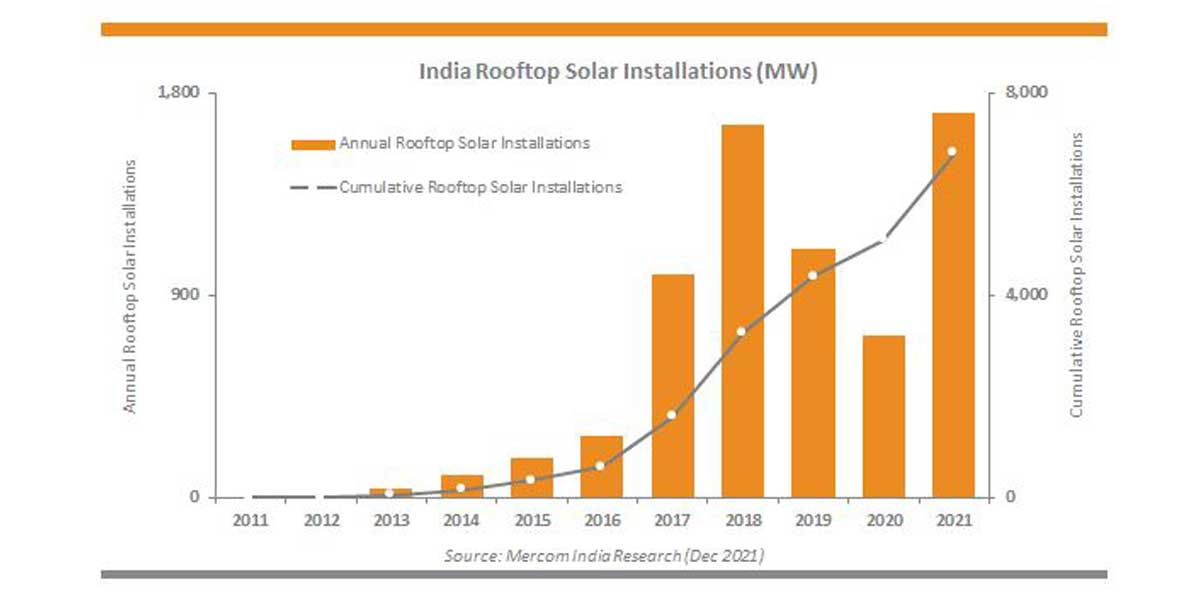In calendar year (CY) 2021, India added 1.7 GW of rooftop solar, the highest ever recorded in a calendar year. Installations were up 210 per cent compared to the CY 2020, according to Mercom India Research’s newly released Mercom India Rooftop Solar Market Report Q4 and Annual 2021.
India added 402 megawatts (MW) of rooftop solar in the Q4 2021, a 10 per cent drop quarter-over-quarter (QoQ) compared to 448 MW installed in Q3 2021. However, rooftop solar installations in Q4 2021 were up 41 per cent year-over-year (YoY). In Q4 2021, rooftop solar accounted for 15 per cent of total solar installations in the country.
In CY 2021, the residential and commercial segment accounted for 35 per cent and 33 per cent of installed rooftop solar capacity, respectively. Industrial rooftop solar installations constituted 26 per cent, and the remaining 6 per cent was from the government segment.
“The rooftop solar market in India had its best year, largely due to the pent-up demand from 2020, which experienced a severe decline due to COVID-19. Certainty around net metering regulation helped along with demand from consumers across all segments – residential, commercial and Industrial. Increase in component costs will dent demand in 2022, but we still expect positive growth this year,” said Raj Prabhu, CEO of Mercom Capital Group. According to the report, at the end of Q4 2021, cumulative rooftop solar installations reached over 7 GW.
Installations could have been higher if not for price increases in components, commodities and raw materials. The increase in the rate of goods and services tax (GST) was also a big blow for installers. The average cost of a rooftop solar system increased by 14.75 per cent compared to Q4 2020, according to the report. Installers had to increase prices in 2021 to match the 12 per cent GST hike and combat materials cost increases.
In 2021, over 1 GW of rooftop solar tenders were issued, a 56 per cent increase YoY. The Kerala State Electricity Board (KSEB) contributed to 27 per cent of announced tenders and distribution companies in states like Maharashtra, Jharkhand, West Bengal and Karnataka, accounted for 29 per cent.
According to the report, distribution companies issued empanelment tenders in Kerala, Punjab, Gujarat, Uttar Pradesh, Jharkhand, Haryana, West Bengal, Tripura and Karnataka under Phase-II of MNRE’s rooftop solar program during CY 2021.
Gujarat is the leading state for cumulative rooftop solar installations with 27 per cent, followed by Maharashtra and Rajasthan, which added 14 per cent and 10 per cent, respectively. The top 10 states accounted for approximately 83 per cent of cumulative rooftop solar installations in Q4 2021 and 85 per cent of total installations in CY 2021. Between Q4 2020 to Q4 2021, Maharashtra recorded the highest compounded growth at 26.7 per cent, followed by Uttarakhand and Haryana with growth rates of 26.6 per cent and 24.7 per cent, respectively.

A comprehensive analysis of the net metering policies across all Indian states and Union Territories are also included in the report. The Mercom India Rooftop Solar Report Q4 2021 is 55 pages and covers all facets of India’s rooftop solar market. For the complete report, visit: https://mercomindia.com/product/q4-2021-india-rooftop-solar-market-report
Key Highlights from Mercom India Research’s India Rooftop Solar Market Report Q4 & Annual 2021
In CY 2021, India added over 1.7 GW of rooftop solar capacity, the highest in any calendar year to date.
Cumulative rooftop solar installations are over 7 GW as of Q4 2021.
The top 10 states accounted for nearly 85 per cent of the rooftop solar installations in CY 2021.
In Q4 2021, 44 per cent of rooftop solar installations came from the commercial segment, followed by 41 per cent, 10 per cent, and 5 per cent in industrial, residential, and government segments.
In Q4 2021, about 68 per cent of rooftop solar installations were under the CAPEX model, while additions under the OPEX/RESCO model contributed to the remaining 32 per cent.
Gujarat was the top state for total rooftop solar installations to date, followed by Maharashtra and Rajasthan ranking second and third, respectively.
YoY, rooftop solar system costs have increased by 14.75 per cent.




















